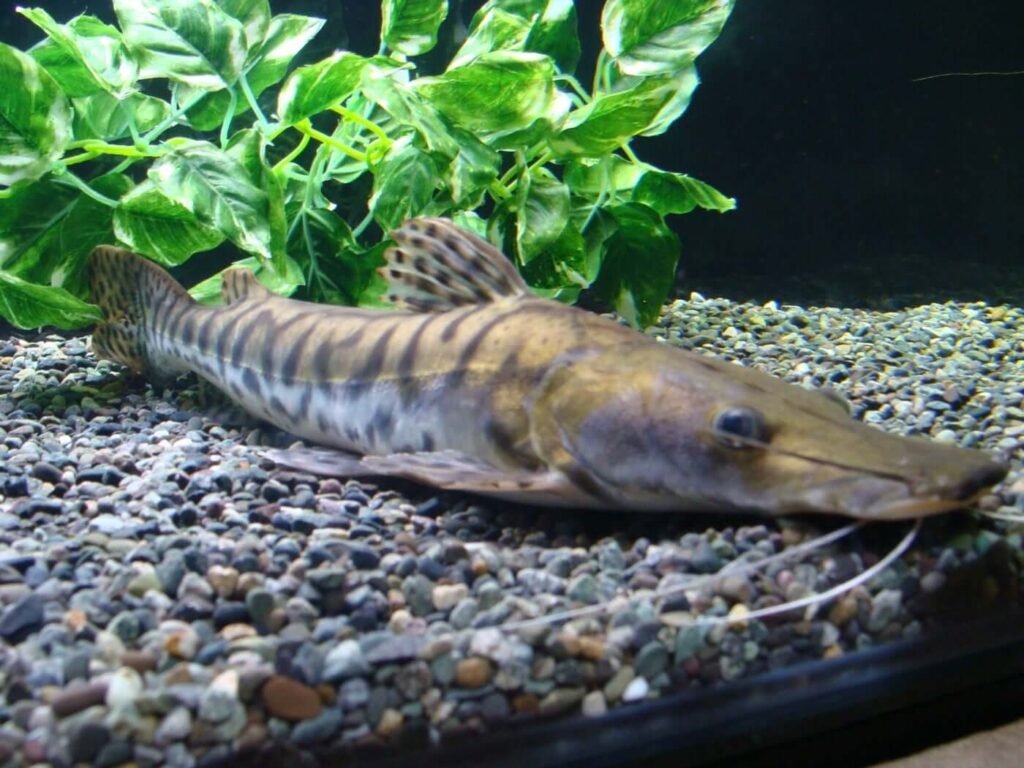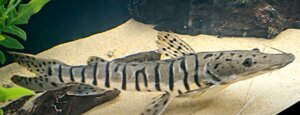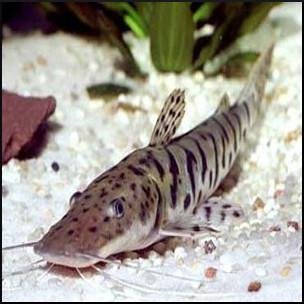The Tiger Shovel Nose Catfish is a unique aquatic fish that has attracted the attention of aquarists for many years. Their size and temperament make them impressive to look at in a tank, but also presents fish enthusiasts with some challenges.
In this guide we address these challenges and present information to assist with keeping this fascinating species in your aquarium.
Introducing the Tiger Shovel Nose Catfish

The Shovelnose tiger catfish (Pseudoplatystoma fasciatum), also known as the Barred Sorubium or Tiger Spade Nose Catfish, is a large fish that can grow to four feet in the wild.
Native to the Amazon River basin, catfish can be found in the deepest sections of rivers, residing in the shade of overhangs or in amongst river logs.
Shovelnose catfish tend to live in dark, murky waters where their vision isn’t very useful. They have sensitive barbel whiskers, which are used to search out food using touch and taste.
Prices pulled from the Amazon Product Advertising API on:
Product prices and availability are accurate as of the date/time indicated and are subject to change. Any price and availability information displayed on [relevant Amazon Site(s), as applicable] at the time of purchase will apply to the purchase of this product.
Their ‘catfish’ name came about by having these whiskers, and the fact that when caught by a fisherman they make a noise like a cat purring.
Because of their size and taste, these fish are sought after by local fishermen, being regarded as good-eating sport fish. They are regularly found for sale in South American fish markets.
Tiger shovelnose are solitary creatures and nocturnal hunters. In the wild, they feed on fish, crustaceans, and even larger animals such as small mammals and birds.
Tiger Shovel Nose Catfish Appearance
Their long, lean body has a solid silvery gray glow. Dark streaks and spots are spread all over the body and can give the catfish the appearance of a tiger.
These river monsters have large flat mouth that helps them capture their prey. The barbels are long, sloping down, and protrude from the front of your jaw. These are used to locate prey. The dorsal fins are medium in size and folded back in a shell-like pattern.
Size
These catfish can become huge in an aquarium and need a lot of room to swim!
In the wild, specimens can grow as large as four feet long and weigh as much as 70 pounds. Aquarium kept fish wouldn’t reach this size.
Catfish grow continuously throughout their lives. No matter how little you feed them or how small the tanks are, they will quickly grow into something huge. Expect your aquarium Shovelnose catfish to eventually grow to about 30 inches long (2.5 feet).
Females grow larger than males, reaching sexual maturity at about 22 inches and males at 18 inches.
How fast do they grow?

When fed correctly Shovelnose catfish can grow 12″ every 2 years, reaching their full length in 5-6 Years. This is only achievable with a big enough tank and when fed a variety of meaty foods. Most people simply don’t have the space in their homes for a suitable tank and often get rid of their catfish at around 3-4 years.
How long does a tiger shovel nose catfish live?
The lifetime of the tiger shovelnose catfish in captivity is about 18-20 years. Longevity is influenced by genetic influences and the level of treatment to which these fish are subjected. Wild fish live longer.
Are they dangerous?
Tigernose catfish are very ferocious looking and do have an aggressive nature. If the tank you use to house them in is overcrowded with aquarium decorations and other species of fish, Tiger catfish may become hostile.
They are a species of fish that hunts for its food, and will willingly eat smaller tankmates.
It is best to house Tigernose Catfish in a long and wide tank, allowing them the space they need, and match tankmates that have the size and similar nature to be able to defend themselves.
Tigernose catfish do not have venomous spines that can harm people or tankmates.
Aquarium Care

Tank Size
Tiger Shovelnose Catfish is a predatory monster that an experienced aquarist should only keep with a huge tank.
These fish can get anxious when stressed and react quickly by rising to the surface, splashing water everywhere. They become very active in the tank when agitated.
Juveniles less than 6 inches long must be in a tank of at least 55 gallons.
As these fish grow, they will require a much larger tank to cater for their size. A tank would need to be at least 180 gallons.
Prices pulled from the Amazon Product Advertising API on:
Product prices and availability are accurate as of the date/time indicated and are subject to change. Any price and availability information displayed on [relevant Amazon Site(s), as applicable] at the time of purchase will apply to the purchase of this product.
Tank Considerations
The tank you house these fish in needs to be robust. Due to the size they can grow to, and their aggressive fast swimming nature when agitated or frightened, these fish can break glass, especially aquarium lids if they jump.
The catfish dwells in the lower portions of the tank, so a long and wide tank is better suited for this species. This allows for them to have room to turn around and swim naturally.
What to Put in Their Tank
Tiger Shovelnose Catfish suffer from stress or aggression when in an empty tank. By replicating their natural environment by including rocks, driftwood or bogwood, and plants into your tank they will feel more at home with places to hide.
Tank Mates
They can live alone or in community with other catfish. Due to their aggressive nature, it is important to match them with tank mates that are of similar size and are robust enough to take a few knocks.
Shovelnose catfish will pick on other fish that cannot stand up for themselves and get territorial (especially if there is not enough room).
Tankmates would need to be resilient species of fish. Such fish would include: Arowana, other large catfish like the Redtail Catfish, Giant Gourami, Pacu, and even Oscar fish. Just make sure there is room in your tank.
You must try to disperse aggression; otherwise, it will not be possible to keep Tiger Shovelnose Catfish in communities tanks. Therefore look for robust, but peaceful tankmates.
Water parameters
Tiger shovelnose catfish are hardy freshwater fish species that can tolerate a wide range of water parameters. They require minimal maintenance once the tank is set up properly.
Prices pulled from the Amazon Product Advertising API on:
Product prices and availability are accurate as of the date/time indicated and are subject to change. Any price and availability information displayed on [relevant Amazon Site(s), as applicable] at the time of purchase will apply to the purchase of this product.
Quality water is one of the most crucial aspects of good fish care, and when taken seriously you can expect fish to be healthier and live longer. Do regular water checks using a reliable testing kit, make water changes and attended to tank maintenance.
- Water temperature: 75°F to 82°F.
- pH levels: 6-8.
- Water hardness: 6-20 KH.
What to do when Tiger Shovel Nose Catfish outgrow their tanks
Careful planning in the beginning is required before embarking with keeping this species of fish.
Many inexperienced hobbyists are attracted to the juvenile Shovelnose Catfish in the aquarium stores. These smaller fish look unique, are very attractive with their large mouths and whiskers and appear harmless. However, they discover quickly that their little catfish soon becomes a tank giant and outgrows its home and they are wanting to give their fish away.
Most public zoos and aquariums may no longer accept these monsters, so finding a home may not be easy. They should never be thrown out into the wild as they are a skilled predator that can degrade native species and their natural habitats.
Diet
Tiger shovelnose catfish are not picky eaters. In the wild they hunt for prey consisting of crustaceans, fish, frogs and other smaller animals that cross their path.
Feed them a balanced diet consisting of a mixture of frozen foods, worms, and pellets. For a treat, offer shrimp and pieces of fish.
Ensure you provide enough food for these fish to match their size and appetites.
Never overfeed your catfish; overfeeding is the leading cause of poor water quality leading to health problems. If you accidentally overfeed your fish, proceed with a water change as soon as possible.
These nocturnal fish prefer to forage for food when the lights go out.
Breeding Tigernose Catfish
Tiger Shovelnose catfish are very difficult to breed in aquariums since they need plenty of space to breed. They can however be bred in large ponds. Having a pond that replicates the muddy rivers they originate from will be helpful in enticing this species to breed.
There is no know external ways to sex these fish. Females do grow larger than males, but otherwise they have the same appearance.
We suggest that you do not attempt to breed them in your tank, rather just enjoy the extraordinary beauty of this species.
Common diseases
Tiger shovelnose catfish have no specific diseases or ailments. Illnesses that they may get can usually be attributed to poor water quality or overcrowding.
In this case, follow the basics of water health. Perform water tests, provide healthy food with no leftovers, and reduce tank stress.
If you get it right, the tiger can live a long time.
A Tiger Shovelnose Catfish aquarium tank should have a quality filtration system since these fish are sensitive to poor water quality.
Final Thoughts – Tiger Shovel Nose Catfish
The tiger shovelnose catfish are an impressive species and make great pets for anyone with the space to accommodate them. Raw quality, power, and unique appearance will make them an instant stand out! They are active fish that never cease to entertain!
.

![[Detailed Guide] Tiger Shovel Nose Catfish Tiger Shovel Nose Catfish](https://aquariumhunter.com/wp-content/uploads/2021/11/46eb36b37540a36b712a3a6c9456afa3.jpg)


